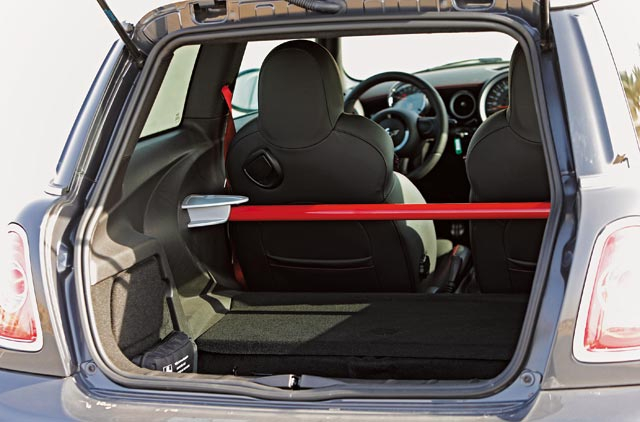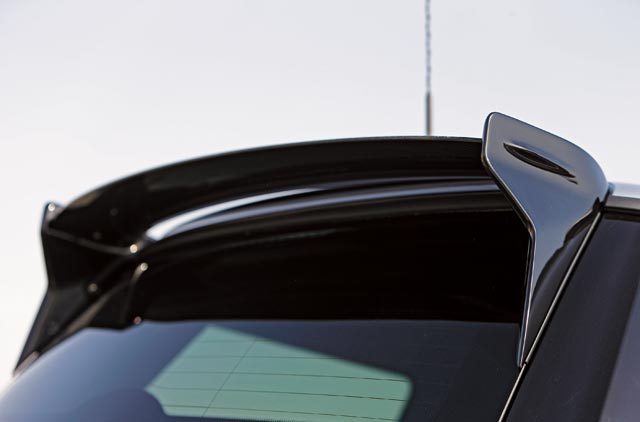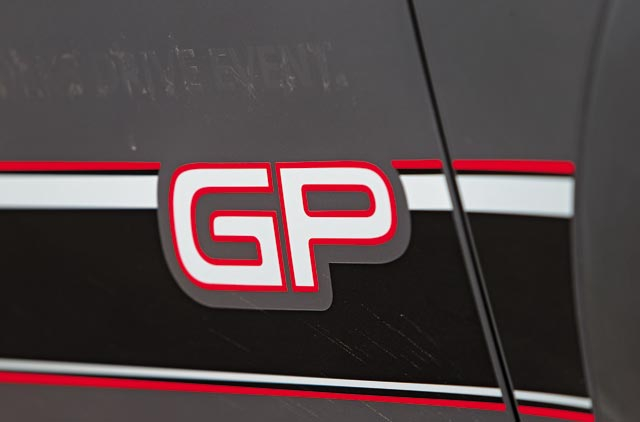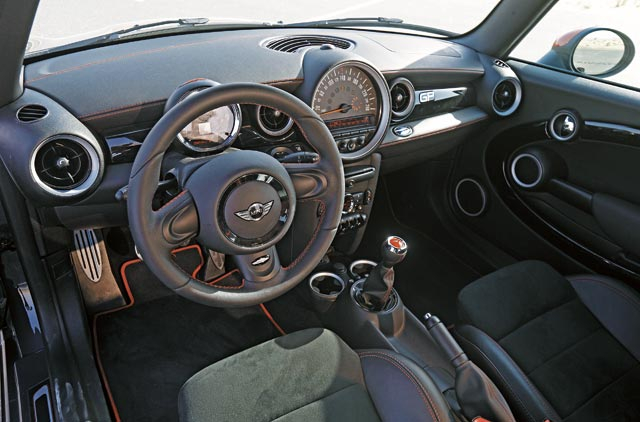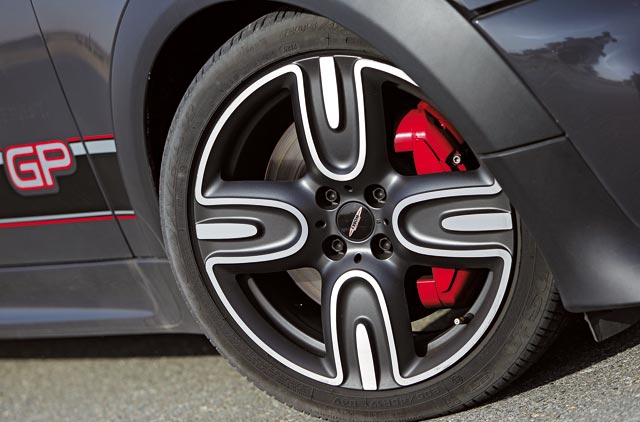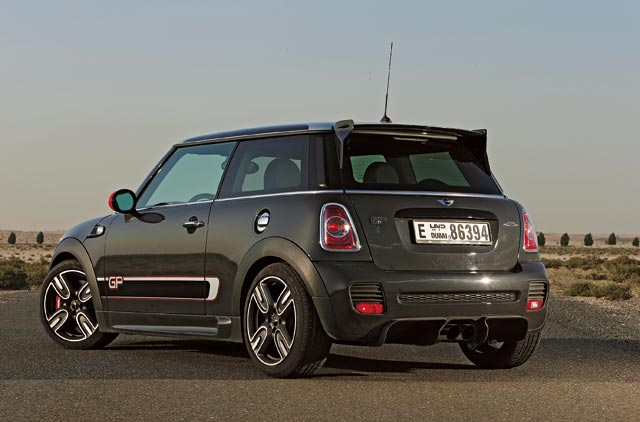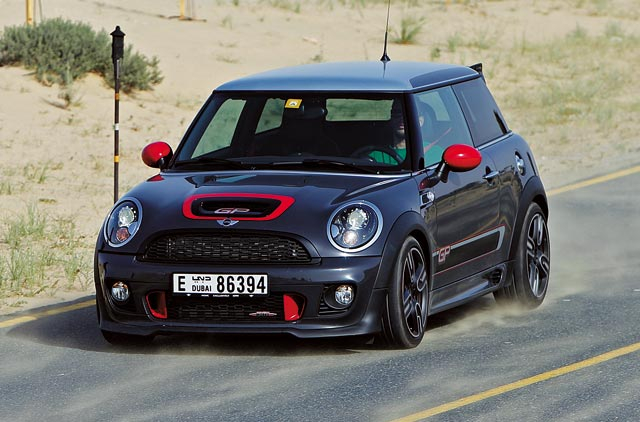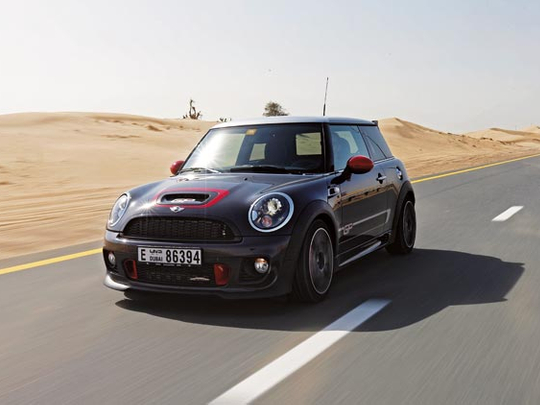
In the new limited-edition fastest Mini ever built, you see, you get a whole lot less, for less. It costs Dh155,000, which is about the same price as a modestly equipped JCW, but 20 grand cheaper than one optioned up to the hilt. The GP however, is bone dry. But there’s also more, boy, is there more…
The brief for the GP was very simple: make a reasonably practical supermini utterly impractical. Then go through the checklist: hot engine, standard equipment; tuned suspension, standard; bigger brakes, standard; sticky tyres, standard; drive it like you stole it, standard equipment...
It is impossible to get in this car and not turn every work commute into a Col de Turini blast. The tyres will chirp in chorus, you will yank the handbrake frequently — Mini knows this, and that’s why in the GP it’s omitted the cumbersome armrest in other models that just gets in the way of your Rauno Altonen-inspired flicks.
I said just a couple of weeks ago that the Ford ST was the best hot hatch in the world, and it is, because it has four doors and seats five and it’s dirt cheap. But this GP is one of the fastest, most extreme, most pointless hot hatches on the planet. If your face isn’t riddled with pimples you’ll look a bit out of place in the JCW GP. It’s got the equivalent of automotive acne, as it sits there all rebelliously, spotted with decals, badges, scoops and vents. It looks completely ridiculous, before you even notice that rear spoiler.
Things start badly, though. There is no multifunctional steering wheel, no sat-nav, colour display, no fancy sound system, cruise control, or indeed, any rear seats. Instead you get a huge strut brace smack through the middle of the vast new cargo compartment, with an uneven load floor. Everyone will just think you’re a tool who’s dropped the rear bench flat to lower the centre of gravity.
There is no supple leather either, just an anthracite roof liner, black dashboard surfaces and a thicker steering wheel. Mini says all this lack of anything is to improve the driver’s concentration and let you get on with chucking the GP into corners like a kart, but really, it’s to keep costs reasonable. With a top-of-the-line JCW cresting Dh175K, do you think there are any people out there who would pay 200 grand for a little hatchback? Even one limited to 2,000 examples worldwide?
So for Dh155K, at least you do get some fantastically embracive Recaro seats and red seatbelts, just like in a Ferrari. Red always equals speed. To replace one of these Recaro seats costs 5,000 euros (Dh23,900). You will get in like you’re perching yourself on top of a sleeping toddler. Dubai’s allotment of the 2,000 limited-edition run of GPs is just five at the moment, with three more scheduled to arrive. They’re flying out of the showroom as they fly everywhere else.
So far it’s been mostly a case of ‘less’, but the GP justifies its pricing with some more meaningful upgrades. Mini says the car’s lapped the Nürburgring Nordschleife in 8:23, which makes the GP faster than the Nissan 350Z, Audi RS4 and Lotus Exige S. Even as it whips past you in a blur, you probably won’t fail to notice it. The car comes exclusively in Thunder Grey metallic, with red accents around the bonnet scoop, side mirrors and front air intakes. JCW badges are found front and rear, but the GP motifs appear down the sides and on the bonnet itself in huge letters. The body’s also swelled up with larger front and rear aprons, side sills and that roof spoiler, which, together with a serious looking rear diffuser and underside panelling, reduces lift at the rear axle by 90 per cent. Ninety per cent, as it turns out, isn’t enough to stop the GP exhibiting its tail-happy nature.
A modest six per cent reduction in vehicle drag also isn’t enough to improve on the JCW’s quite excellent fuel economy figures (we averaged 5.5 litres-per-100km in a normal commute with the automatic JCW), but that’s because you’ll rarely settle for much less than the GP engine’s 6,000rpm peak.
The modified four-cylinder engine, found nestled longitudinally in BMW’s base 3 Series, is modified here to produce 218bhp, which is just a shade more powerful than the same turbocharged 1.6-litre found in the regular JCW. The GP receives reinforced pistons, sturdier cylinder head, low-weight crankshafts and sodium-filled exhaust valves, while direct petrol injection and aluminium block and bearing mounts remain. Maximum torque is 280Nm from 2,000rpm on overboost (same as a JCW) and the grunt gets up front exclusively via a six-speed manual transmission.
All that torque is great, but the clutch action is too light, and the gear change — although the Getrag is amongst the best ’boxes around — succumbs to a slightly loose and long throw for such an immediate, fiery car. Pulling off in second from a roll is impossible, and keeping the torque flowing necessitates lots of rowing along.
This is a very lightweight car: a GP weighs 1,160kg compared to the 1,235kg JCW, which makes it almost identical to the Mini Challenge race car. Yet the Goodyear Eagle tyres can’t handle full acceleration out of the turns, even if the car, sitting on fully adjustable coilover suspension and redesigned geometry, wants to lean in, hunker down and go. These Goodyears are no doubt great tyres, but they’re run-flats whereas the JCW GP was developed with regular rubber in mind — other markets get non-run-flat Kumhos. The Goodyears are thus also very noisy, and their sidewalls overly stiff.
To be fair, the GP isn’t as tail-happy a car as a Focus ST or even one of the hot Alfa Mitos or Renaultsport Clios — there is no need to correct with the steering wheel, even when the rear starts gently easing away through a fast sweeper with throttle lift-off. All you have to do is flatten the accelerator pedal and the car will get back on line. It’s all point and squirt — with such a tiny wheelbase and wide 1,473mm track, its footprint is basically a square, but the GP still doesn’t tramline or succumb to unfavourable road cambers; it tracks straight and true like a much larger and heavier car on something way bigger than humble 215/40 R17 (lightweight and exclusive) wheels and tyres. It is extremely refined in its stability, but that same tiny footprint also means its handling responses are immediate, thanks in part also to the 20mm dropped ride height, and a new GP stability control mode that electronically utilises limited slip-diff mimicry by braking inside wheels. Speaking of brakes, the bigger 330mm and 280mm front and rear discs sort out the stopping power with a sensitive and soft middle pedal — placement is great, but the sensitivity makes rev-matching a lurching, learning affair.
With a Dh155K asking price it seems you’re paying for less, seeing as the power is almost equal to a much better equipped JCW model. But Mini redeemed itself by throwing in the sumptuous Recaro buckets (manually adjustable, naturally) and all those chassis tweaks that turn a hot car into an intimate scorcher. And at the end of the day you’ll always have that giant strut brace, plus it’s red.


